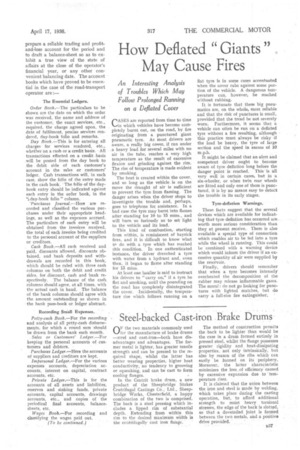How Deflated " Giants " May Cause Fires
Page 51

If you've noticed an error in this article please click here to report it so we can fix it.
An Interesting Analysis of Troubles Which May Follow Prolonged Running on a Deflated Cover
The Essential Ledgers.
Order Book.—The particulars to be shown are the date on which the order was received, the name and address of the customer, the exact services, . etc., required, the charge agreed upon, the date of fulfilment, precise services rendered, day-book folio and remarks.
Day hook .—This is for entering all charges for services rendered, etc., whether on a cash or a credit basis. All transactions effected on a credit .basis .will be posted from the day book to the debit• side of each customer's account in the sales or customers' ledger. Cash transactions will, in each case, show the folio of the entry made in the cash book. The folio of the daybook entry should be indicated against each entry in the order book, in the
day-book folio" column.
'Purchases Journal.—Here are recorded and classified the various purchases under their appropriate headings, as well as the expenses accrued. The particulars of each entry will be obtained from the invoices recejved, the total of each invoice being credited to the personal account of the suppliers or creditors.
Cash Book.—All cash received and paid, discounts allowed, discounts obtained, and bank deposits and withdrawals are recorded in this book, which Should be ruled with three cash columns on both the debit and credit sides, for discount, cash and bank respectively. The balance of the cash columns should agree, at all times, with the actual cash in hand. The balance of the bank columns should agree with the amount outstanding as shown in
• the bank pass-book or ledger abstract.
Recording Small Expenses.
Petty-cash Book.—For the recording. and analysis of all petty-cash disbursements, for which a round sum should be drawn from the bank each month.
Sales or Customers' Ledger.—For keeping the personal accounts of customers and debtors.
Purchases Ledger.—Here the accounts of suppliers and creditors are kept.
Impersonal Ledger.—For the various expenses accounts, depreciation accounts, interest on capital, contract accounts, etc.
Private Ledger.—This is for the
accounts of all assets and liabilities, reserves and sinking funds, private accounts, capital accounts, drawings accounts, etc., and copies of the periodical final accounts, balancesheets, etc.
Wages Book,—For recording and classifying the wages paid out. CASES are reported from time to time in which vehicles have become completely burnt out, on the road, by fire originating from a punctured giant pneumatic tyre. As most drivers are aware, a really big cover, if run under a heavy load for several miles with no air in the tube, reaches a very high temperature as the result of excessive flexion and grinding against the rim. The rise of temperature is made evident by smoking.
The heat is created within the cover, and so long as the vehicle is on the move the draught of air is sufficient to prevent the tyre from flaming. The danger arises when the driver stops to investigate the trouble and, perhaps, goes to telephone for assistance. In a bad case the tyre may burst into flames after standing for 10 to 15 mins., and will burn so furiously as 'toset light to the vehicle and its load, This kind of combustion,starting from within, is reminiscent of hayrick fires, and it is difficult to know what to do , with a tyre which has reached this condition. In one authenticated instance, the driver drenched a tyre with water from a hydrant and, even then, it began to flame after standing for 15 reins.
At least one haulier is said to instruct his drivers to "carry on," if a tyre be flat and smoking, until the pounding on the road has completely disintegrated the cover. -Incidentally, the temperature rise which follows running on a
fiat tyre is in some cases accentuated when the cover rubs against some portion of the vehicle. A dangerous temperature can, however, be reached without rubbing.
It is fortunate that these big pneumatics are, on the whole, most reliable and that the risk of punctures is small, provided that the tread be not severely worn. Furthermore, it seems that a vehicle can often be run on a deflated tyre without a fire resulting, although this practice must always be risky if the load be heavy, the tyre of large section and the speed in excess of 10 m.p.h.
It might be claimed that an alert and competent driver ought to become aware of tyre deflation long before the danger point is reached. Thisis all very well in certain cases, but in a six-wheeler, or when twin rear Wheels are fitted and only one of them is punctured, it is by no means easy to detect the trouble in its early stages.
Tyre-deflation Warnings.
These facts suggest that the several devices which are available for indicating that 'tyre deflation has occurred are. worth more serious consideration than they at present receive. There is also available a special type of connection which enables air to be fed into a tyre while the wheel is running. This could be combined with a warning device which would inform the driver if an excessive quantity of air were supplied by the reservoir.
Finally, drivers should remember that when a tyre becomes intensely overheated the decomposition of the rubber may release inflammable gases. The moral : do not go looking for punctures with lighted matches, but do carry a full-size fire extinguisher. '






























































































